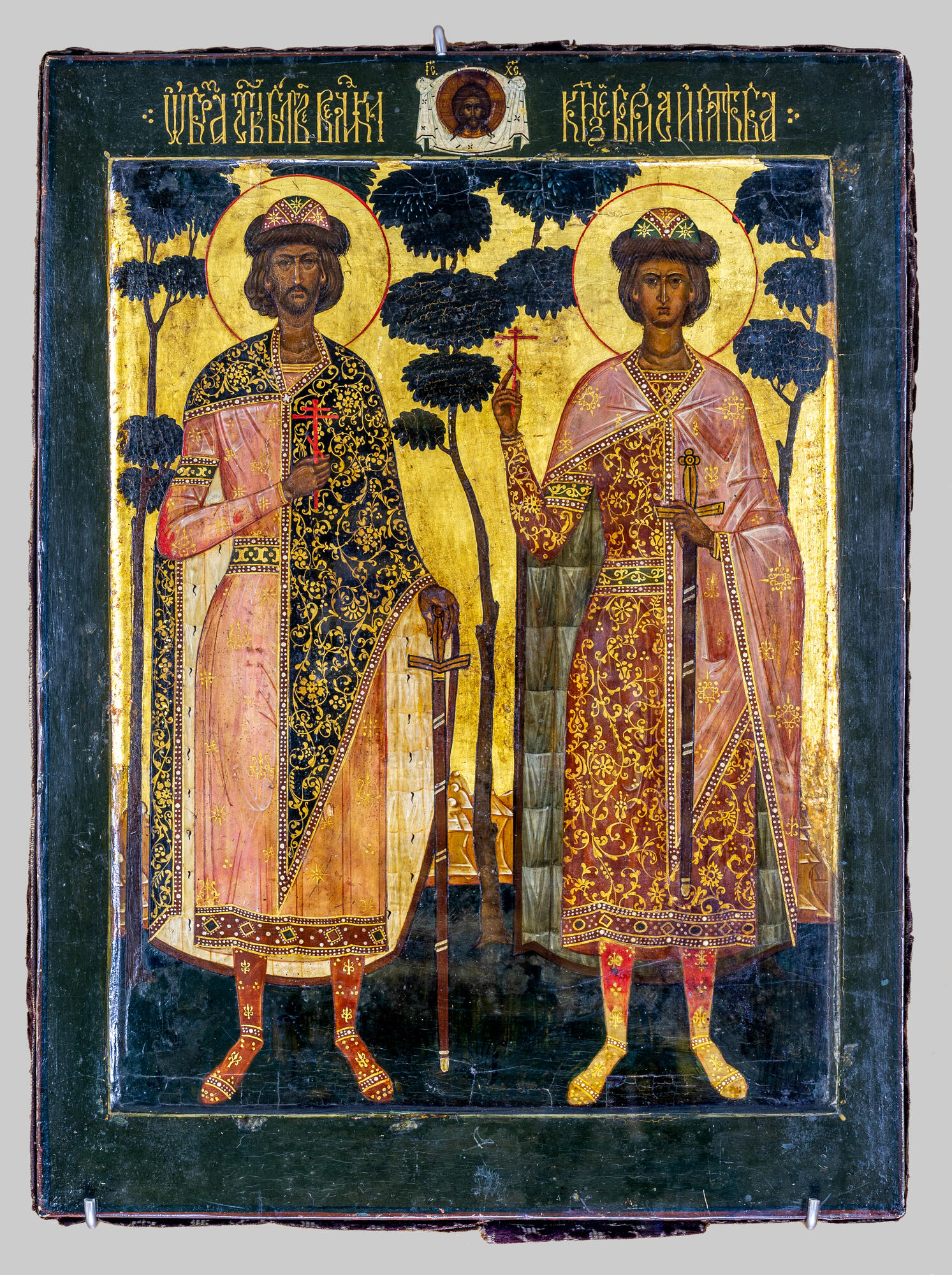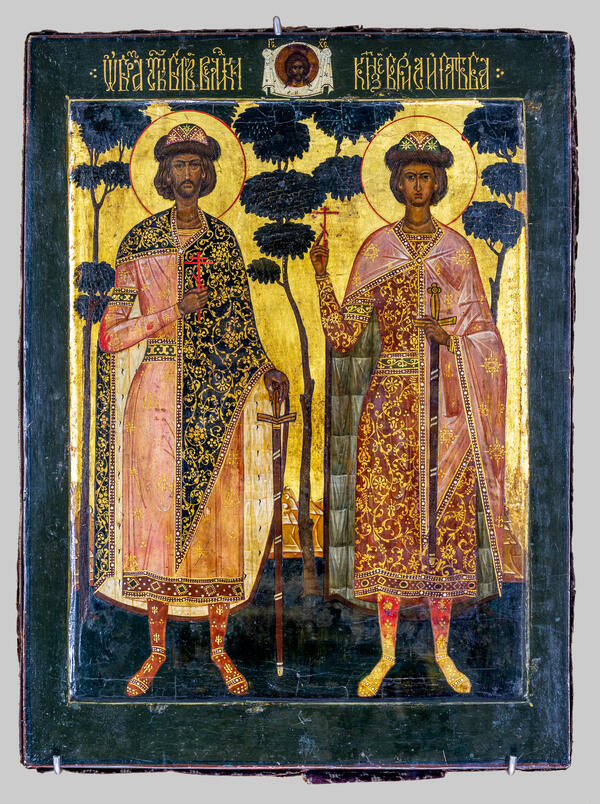The ‘Boris and Gleb’ icon was painted in the early 20th century.
The artist portrayed two Russian princes: Boris and Gleb. They were sons of the Prince of Kyiv, Vladimir Svyatoslavovich, who christened Rus. Their half-brother Svyatopolk cowardly murdered them. At first, the saints were revered as passion-bearers (as they call all the martyrs who endured suffering), whose relics have a special healing power. Later on, they became the patrons of the military affairs.
The Palekh artist’s icon is of the early type of Boris and Gleb iconography. The brothers are portrayed in prince clothing, which is the tradition. They are painted as martyrs and warriors: with vermilion-red crosses and lowered swords in their hands. The iconography tradition dictates that Boris should be portrayed with a short beard and long hair, and Gleb should be a young man with a round face and short hair.
Boris is wearing a long yellow-pink shirt and a blue-black patterned cloak with ermine padding. Gleb is wearing a red-brown shirt and a pink cloak with a green-ish padding. Both are wearing princely domed round hats with fur fringes. Gleb’s boots are yellow-ocher, with gold patterns. A splash of bright vermillion is added on top, just like on the elbow bend of Boris’s right hand.
This icon painted by a Palekh artist is a prime example of “podstarinniy” painting style which dominated the provincial icon painting scene in the late XIX century, especially in Mstera and Palekh. The “podstarinniy” style is an artists' attempt to recreate the old style of icons.
Both Boris and Gleb are flat figures, without any excessive natural volume — which is a deliberate choice. The folds of their clothes are created with color, not the play of light and shade. The artist applied whitewash in a barely noticeable translucent layer. He painted the shadows with dense tones — they are even darker than the main color of the clothes. The hills are depicted on the icon in a very conventional manner, and the trees are depicted in a Palekh icon tradition.
The artist painted the visages using the 16th century technique from Moscow. Over the greenish-brown layer the author softly laid further fused layers of ocher with a faint browning. He painted the volumes without any sharp lightenings or “dvizhki” (“dvizhki” are the fine white lines used in icon painting to create volume on open body parts; they liven up the image, and are sometimes also called “ozhivki”). The artist also used whitewash whitewash to highlight the brow ridge and the auricles, and to add glare to the eyes.
The inscription on the top field is made with gold. The overly ornate ligature made it barely legible. This intricacy, previously quite uncommon for the people of Palekh, became very widespread on the icons of the late 19th–early 20th century.
The artist portrayed two Russian princes: Boris and Gleb. They were sons of the Prince of Kyiv, Vladimir Svyatoslavovich, who christened Rus. Their half-brother Svyatopolk cowardly murdered them. At first, the saints were revered as passion-bearers (as they call all the martyrs who endured suffering), whose relics have a special healing power. Later on, they became the patrons of the military affairs.
The Palekh artist’s icon is of the early type of Boris and Gleb iconography. The brothers are portrayed in prince clothing, which is the tradition. They are painted as martyrs and warriors: with vermilion-red crosses and lowered swords in their hands. The iconography tradition dictates that Boris should be portrayed with a short beard and long hair, and Gleb should be a young man with a round face and short hair.
Boris is wearing a long yellow-pink shirt and a blue-black patterned cloak with ermine padding. Gleb is wearing a red-brown shirt and a pink cloak with a green-ish padding. Both are wearing princely domed round hats with fur fringes. Gleb’s boots are yellow-ocher, with gold patterns. A splash of bright vermillion is added on top, just like on the elbow bend of Boris’s right hand.
This icon painted by a Palekh artist is a prime example of “podstarinniy” painting style which dominated the provincial icon painting scene in the late XIX century, especially in Mstera and Palekh. The “podstarinniy” style is an artists' attempt to recreate the old style of icons.
Both Boris and Gleb are flat figures, without any excessive natural volume — which is a deliberate choice. The folds of their clothes are created with color, not the play of light and shade. The artist applied whitewash in a barely noticeable translucent layer. He painted the shadows with dense tones — they are even darker than the main color of the clothes. The hills are depicted on the icon in a very conventional manner, and the trees are depicted in a Palekh icon tradition.
The artist painted the visages using the 16th century technique from Moscow. Over the greenish-brown layer the author softly laid further fused layers of ocher with a faint browning. He painted the volumes without any sharp lightenings or “dvizhki” (“dvizhki” are the fine white lines used in icon painting to create volume on open body parts; they liven up the image, and are sometimes also called “ozhivki”). The artist also used whitewash whitewash to highlight the brow ridge and the auricles, and to add glare to the eyes.
The inscription on the top field is made with gold. The overly ornate ligature made it barely legible. This intricacy, previously quite uncommon for the people of Palekh, became very widespread on the icons of the late 19th–early 20th century.



